
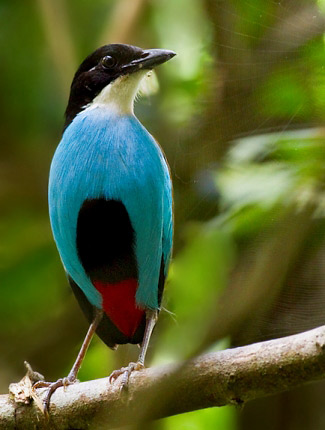
A stunning Steere's or Azure-breasted Pitta in Rajah Sikatuna National Park on the island of Bohol in the Philippines by Dubi Shapiro.
ASIA and THE MIDDLE EAST
The destinations listed and linked below are the ones we believe are the best in Asia and The Middle East. They have been chosen very carefully and for a multitude of reasons, but mainly based on personal experience of some of them and on dreams of visiting the rest, dreams resulting from what we have heard, read or seen.
It is our intention to update this list regularly as we add destinations and it was last updated in May 2021.
If there are any other destinations you think should be on the list below then please feel free to Email us.
The destinations are listed alphabetically with very brief summaries for those linked, in dark blue, to more detailed pages (to reach these pages click on the destination name). Those not linked to more detailed pages are described in a bit more detail here, in italics, under light blue headings.
For more information see ...
The Best (100) Birds in the World,
The Best (100) Wildlife in the World and
Best (50) Other Natural Wonders.
Destinations
The first and arguably most important destination to consider is a Local Patch, somewhere a short walk from home where it is possible to see a wide range of birds and other wildlife any day of the year.
A
Afghanistan
Hardly anyone has been travelling, let alone birding, in Afghanistan for decades. Bad news for birders because, apart from a number of Central Asian and
west Himalayan specialities, including Tibetan Sandgrouse, Turkestan and White-cheeked Tits, Kashmir and White-cheeked Nuthatches, Afghan (Dead Sea)
Sparrow and Black-and-yellow Grosbeak, there is also the near-endemic Afghan Snowfinch. The British Foreign Office usually advise against all
travel to Afghanistan and yet at least one tour company was planning a trip to Band-e-Amir National Park in the Hindu
Kush in 2021, once one of the most popular tourist destinations in the country. The endemic Afghan Snowfinch occurs there, along with Large-billed
Reed-warbler. The snowfinch was identified in 1937 and described by a British army colonel called Richard Meinertzhagen, a controversial character who was
once considered to be one of Britain’s greatest ornithologists, finding many new species around the world, but who has since been exposed as a fraud,
writing fake diaries and reports, and stealing bird skins from other collections. One by one, all his scientific discoveries have been discredited, except
one, the bird he named ‘Theresa’s Sparrow’, after the zoologist Theresa Rachel Clay who was his cousin. Not much is known about the rest of the current
birdlife but this rugged land of desert, steppe and mountains that rise to 7484 m (24,554 ft) at Mount Zebak in the Pamirs, has many different ecological
zones which support a wide variety of birds and the likes of Snow Leopards and Marco Polo Sheep. The summers are normally very hot, the winters usually
very cold.
Ambon
See Indonesia - Moluccas, below.
Arctic Russia
See Russia -Arctic, below.
Armenia
Landlocked Armenia is dominated by the lofty Lesser Caucasus mountains which rise to 4090 m (13,420 ft) at Mount Aragats although there is also
some semi-desert and a large area of fish ponds at lower elevations. Situated at the junction of Europe, the Middle East and Asia there is a superb
selection of birds to be seen in a very small area just a quarter the size of England, including Pygmy Cormorant, Marbled Teal, White-headed Duck
(Armash fish ponds), Lammergeier, Levant Sparrowhawk, Caspian Snowcock (Gndasar Mountain), Caucasian Grouse (Tsaghkunyats Mountains), White-tailed
Lapwing (Armash fish ponds), Armenian Gull, Blue-cheeked Bee-eater, Bimaculated Lark, White-throated Robin, Finsch's and Red-tailed Wheatears, Blackstart,
Western and Eastern Rock Nuthatches, Green, Menetries's, Moustached and Upcher's (a late arriving summer visitor) Warblers, Rosy Starling, Radde's
Accentor, Eurasian Crimson-winged Finch and Grey-necked Bunting. During the autumn, especially early September, large numbers of Demoiselle Cranes pass
through Lake Sevan. Mammals include the Bezoar Ibex which occurs in the Yeranos Mountains, and more than 230 species of butterfly include Caucasian
specialities and there is a chance of seeing 80 species during the last week of June including Kurdish Copper and Persian Fritillary. The best time for
birds is late May to the middle of June.
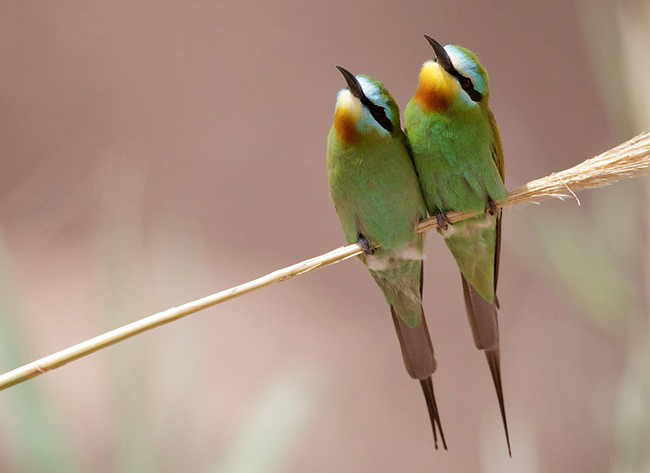
Blue-cheeked Bee-eaters nest in Armenia. Image by Michael McKee.
Azerbaijan
This small country supports a long list of specialities including Caucasian Grouse, Caspian and Caucasian Snowcocks, Black Francolin, See-see Partridge,
Shikra, Black-winged Pratincole, White-winged (Güldenstädt's) Redstart, Finsch’s and Red-tailed Wheatears, Green, Ménétries's and Upcher’s Warblers,
Caucasian (Mountain) Chiffchaff, Semi-collared Flycatcher, Caspian Tit, Eastern Rock Nuthatch, Radde's Accentor, Pale Sparrow (Rockfinch), (Caucasian)
Twite, 'Caucasian' Great Rosefinch, Eurasian Crimson-winged Finch and Grey-necked Bunting, while other birds present include Chukar, Pygmy Cormorant,
Lammergeier, White-tailed Lapwing, Blue-cheeked Bee-eater, White-throated Robin, Rosy Starling, Red-fronted Serin, and Mongolian and Trumpeter Finches.
These birds are best looked for from mid-May to mid-June and the best areas are Hyrcan National Park (Caspian Tit), the High Caucasus (Caucasian Grouse
and Great Rosefinch (Mount Shahdagh)), and the Autonomous Republic of Nakhchiva (Caspian Snowcock, See-see Partridge, Red-tailed Wheatear, Eastern Rock
Nuthatch, Radde’s Accentor and Pale Sparrow). During the northern winter birds include Greater and Lesser White-fronted Geese, Marbled Teal, White-headed
Duck, Dalmatian and Great White Pelicans, Eastern Imperial Eagle, Little Bustard (thousands in and around Aggol National Park), Grey-headed Swamphen and
Pallas's (Great Black-headed) Gull. Many species pass through on migration as well and there is a bottleneck on the the narrow coastal plain below the
rock of Besh Barmag less than 100km north of the capital Baku where over a million birds have been recorded during the autumn/fall including waterbirds,
raptors, rollers and Blue-cheeked Bee-eaters. Mammals are less prominent but aerial maps of Azerbaijan even in the mid-2010s showed the presence of great
tracts of near-pristine forest where Brown Bears, Wolves and even Leopards still lived.
B
Babar
See Lesser Sundas, below.
Bacan
See Moluccas, below.
Bahrain
The small, green farms on this otherwise arid archipelago in the central Arabian (Persian) Gulf attract a wide variety of passage migrant birds, including
Egyptian Nightjar (regular in late October-early November) and Hypocolius (also regular in late October-early November, sometimes all winter), while
rocky hills support (Eastern/Iranian persica) Mourning Wheatear and around the coast are Socotra Cormorants (half the world’s population nests on Bahraini
islets, notably the Hawar Islands which hard to access and also support the world’s biggest colony of Western Reef-egrets). Large numbers of shorebirds
pass through between July and October, and passing landbirds, most numerous in March and April, have included White-throated Robin and Menetries’s Warbler.
Other animals include Indo-pacific Bottlenose Dolphins, Green Turtles and the largest herd of Dugongs in the world, formed when mainly mothers and calves
gather between Bahrain and the Hawar Islands between August and early April, especially in late autumn.
Bali, Indonesia
See Indonesia - Bali, below
Banggai Islands
See Sulawesi's satellites, below.
Bangladesh
This small, heavily populated country is perhaps best known in the world of wildlife for Spoon-billed Sandpipers and the Sundarbans. Up to perhaps 30% of
the few Spoon-billed Sandpipers left on this planet spend the northern winter (November to March) in Bangladesh, along with tens of thousands of other
wintering shorebirds including Spotted (Nordmann’s) Greenshank, Great Knot and Asian Dowitcher. The first specimen of the sandpiper was collected in
Bangladesh in the mid-19th Century and the country still retains the record for the highest single count anywhere in the world; 202 at Moulevir Char in
1989. Since then a count of more than 100 has never been recorded and numbers have fallen to a minimum of 48 on the Meghna Estuary in the mid 2010s. Hatiya
Island near Cox's Bazar, famed for what may be the longest continuous beach in the world, is a major wintering site for Indian Skimmers. The Sundarbans is
thought to be the largest mangrove forest left in the world and the place where there are perhaps more Tigers than anywhere else. Also possible on boat
trips through the creeks are Ganges River Dolphin, the rare Masked Finfoot, Great Thick-knee, and Black-capped, Brown-winged and Ruddy Kingfishers. In the
northeast of the country, near Srimangal, there is a wetland reserve called Hail Haor where Falcated Duck, Pallas’s Fish-eagle (at Baikka Beel), Pied
Harrier, Greater Painted-snipe, and Bronze-winged and Pheasant-tailed Jacanas occur, and several forest parks and reserves including Adampur (Orange-headed
Thrush), Kalachara (Chestnut-headed Bee-eater), Lawachara/Lowacharra (Malay Night-heron, Rosy Minivet, Black-breasted Thrush and Grey-bellied Tesia, as
well as Hoolock Gibbon and Phayre’s Langur), and Satchari (Black Baza, Red-headed Trogon and Common Green Magpie).
Beidaihe and Happy Island - China
See China - Beidaihe, below.
Bhutan
Where vast tracts of pristine forest, Golden Langurs and so many brilliant Himalayan birds are part of the Gross National Happiness, birds such as
Himalayan Monal, Satyr Tragopan, White-bellied Heron, Pallas's Fish-eagle, Ibisbill, Ward’s Trogon, Rufous-necked Hornbill, Beautiful Nuthatch, Himalayan
Cutia and Fire-tailed Myzornis.
Borneo - Malaysia
A Top Ten Destination thanks to Orang-utan, Proboscis Monkey, Bornean Gibbon and many top birds, not least 64 endemics,
including Whitehead’s Trogon, Black-crowned, Blue-banded, Blue-headed and Bornean Banded Pittas, Hose’s and Whitehead’s Broadbills, Bornean Bristlehead,
Everett’s Thrush, Fruithunter and Whitehead’s Spiderhunter, as well as many trogons, kingfishers, bee-eaters, broadbills, hornbills and babblers, all in
some of the oldest, tallest and richest
rainforest on Earth.
Burma
See Myanmar, below.
Buru
See Moluccas, below.
C
Cambodia
Several spectacular birds very difficult or impossible to see elsewhere including Giant and White-shouldered Ibises, Greater Adjutant, Bengal Florican,
White-rumped Pygmy-falcon and Black-headed Woodpecker, the biggest breeding colonies of waterbirds in Southeast Asia with Spot-billed Pelicans and Painted
Storks, and some wonderful mammals such as Yellow-cheeked Gibbon and Black-shanked Douc Langur.
China - Beidaihe and Happy Island
One of the best places to experience bird migration on the planet, just 280 km east of Beijing. The passage migrants, many in summer plumage during
spring, include many species which are rarities in Europe and Alaska, notably cuckoos, pipits, thrushes, flycatchers, warblers and buntings, some of
which turn up in astonishing numbers when there has been a fall (for example, 250 Siberian Blue Robins in one day on Happy Island!). Regular other
species include Chinese Egret, Schrenck’s Bittern, Pied Harrier, Amur Falcon, Baillon’s Crake, shorebirds such as Asian Dowitcher and Grey-tailed
Tattler, Relict and Saunders’s Gulls, White-throated Needletail, Black-capped Kingfisher, Black-naped Oriole, Chestnut-flanked White-eye, Siberian
Rubythroat, Rufous-tailed Robin and Forest Wagtail. A lot of good habitat has been destroyed around the expanding seaside resort of Beidaihe, which is
not as good as it used to be, but Happy Island, about 4 km by 2km and accessible via a 20-minute ferry ride, is still an exciting place to bird, and
arguably the best to find many of the most exciting migrants. The first half of May is the peak time for species diversity during spring but spring
passage begins in March when four species of crane pass over. The peak time in autumn is late September-early October although the cranes pass over
south from mid-October to early November.
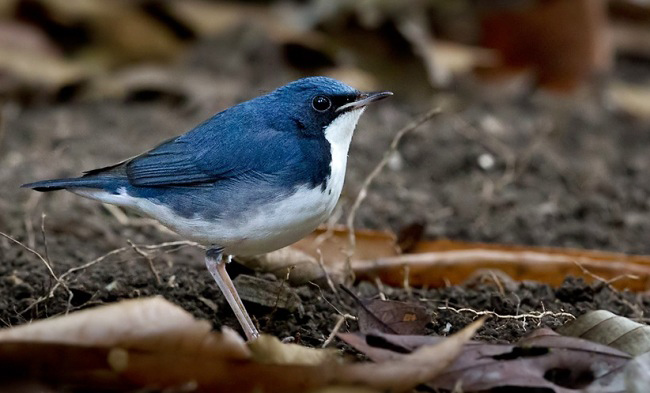
The superb Siberian Blue Robin by Lars Petersson (in Cat Tien National Park, Vietnam, in February).
China - Central
The rare Asian Crested Ibis and Golden Snub-nosed Monkey, as well as a slim chance of Giant Panda, Temminck's Tragopan, Golden Pheasant, Indian Blue Robin
and Blackthroat.
China - Eastern (Poyang Hu)
The 'Birds of Heaven', that is cranes, lots of wintering cranes, including Siberian, White-naped and Hooded, at Poyang Hu, one of the world’s greatest
wetlands where tens, sometimes hundreds, of thousands of waterbirds spend the northern winter, notably Swan Geese and Oriental Storks.
China - Hong Kong
Arguably the best shorebird show on Earth, involving about 10,000 birds of over 30 species, passing through during spring in full summer plumage, including
Asian Dowitcher, Spotted (Nordmann’s) Greenshank, Great Knot and possibly Spoon-billed Sandpiper, alongside the likes of Chinese Egret, Black-faced
Spoonbill and Saunders’s Gull.
China - Sichuan
Very little chance of seeing Giant Panda in the wild but one of the few places where there is a chance of Red Panda, and a long list of fabulous birds,
such as Golden and Lady Amherst’s Pheasants, Temminck’s Tragopan, Chinese Monal, Ground Tit, Sichuan Jay, Grandala, Firethroat, Crested and
White-browed Tit-warblers, Golden-breasted Fulvetta and Gould's Sunbird, all in some stunning mountainous terrain.
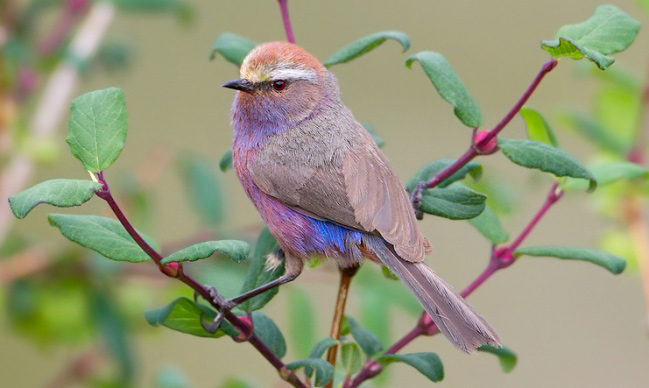
A beautiful White-browed or Severtzov's or Stoliczka's Tit-warbler at Kanda Shan, a mountain pass in Qinghai province adjacent to Sichuan in China by Dubi Shapiro.
China - Yunnan
The richest province for birds in China with about 40 of the 72 mainland Chinese endemics and many species restricted to Yunnan, northern Myanmar and
northeastern India, including Lady Amherst’s Pheasant, Ward's Trogon, Purple Cochoa, lots of laughingthrushes, Himalayan Cutia, Fire-tailed Myzornis, and
Giant and Yunnan Nuthatches, as well as the very rare Black-crested and Hoolock Gibbons, and Yunnan Snub-nosed Monkey.
Christmas Island
Millions of migrating Red Crabs, giant Coconut Crabs, coral reef fish, Whale Sharks, Manta Rays, ‘golden’ White-tailed Tropicbirds, two endemic breeding
seabirds (Christmas Frigatebird and Abbott’s Booby), and four endemic landbirds; an imperial-pigeon, a swiftlet, a boobook and a white-eye.
Cyprus
Situated to the south of Turkey and north of the Nile delta in the eastern Mediterranean the coastal rocky promontories and wetlands on the rugged island
of Cyprus are a great place to see migrating birds especially during the northern spring (mainly late March to mid April) when species passing through
include Pallid Harrier, Little Crake, Slender-billed Gull, Red-throated Pipit, (Black-headed) Western Yellow Wagtail, Isabelline Wheatear and Rüppell's
Warbler, with 'regular' vagrants such as Caspian Plover. Good sites include Cape Greco near Larnaca in the far southeast which has hosted rarities such as
Hypocolius and Cinereous Bunting; the vast salt lake at Akrotiri (for flocks of Greater Flamingos) and the dry plain known as the Akrotiri Gravel Pits, one
of the best areas for migrant passerines, which in turn attract Pallid Harriers; and Paphos (Pafos) Headland in the far southwest, a classic migration site
also famous for its Roman ruins. There are three widespread endemic breeding species; a scops-owl, a wheatear and a warbler, and four endemic subspecies;
Coal Tit (cypriotes), 'Dorothy's' Short-toed Treecreeper (dorotheae), Eurasian Jay (glaszneri) and Red Crossbill (guillemardi),
all of which occur in the Troodos Mountains. Other breeding species include Chukar, Black Francolin, Griffon Vulture, Eleonora's Falcon, Spur-winged
Lapwing, Audouin’s Gull, Great Spotted Cuckoo, Masked Shrike, Spectacled Warbler and Cretzschmar’s Bunting. During the autumn, usually from late August to
early September, Demoiselle Cranes stopover at Akrotiri Salt Lake where thousands of Greater Flamingos spend the northern winter and other wintering
species include Ruddy Shelduck and Finsch's Wheatear (Oct-Mar). There are also 50 species and forms of orchid in the northern Turkish half of the island,
of which about 30 flower together in March-April, including Anatolian, Cyprus Bee, Early Mammose and Eastern Tongue.
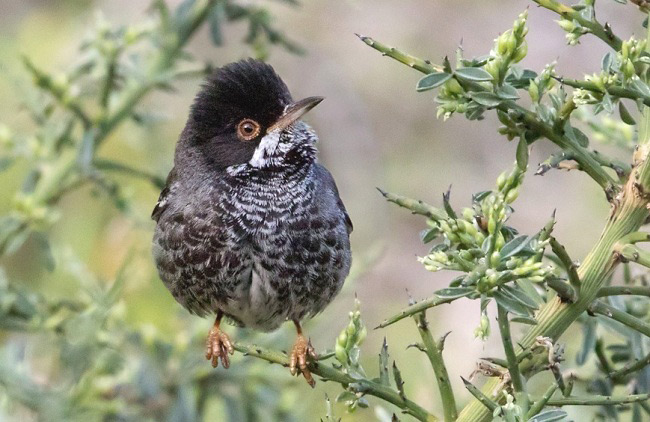
Cyprus Warbler by Lars Petersson.
D
Damar
See Indonesia - Lesser Sundas, below.
E
East Timor
See Timor/Timor-Leste, below.
G
Georgia
Caucasian Grouse, Caucasian Snowcock, White-winged (Güldenstädt's) Redstart and 'Caucasian' Great Rosefinch, in the mountains with Lammergeier, Wallcreeper
and Red-fronted Serin, and Batumi, one of the best places in the world for visible raptor migration, involving over a million birds per autumn/fall, mainly
Honey and ‘Steppe’ Buzzards but also including Great Spotted, Lesser Spotted and Steppe Eagles, and Levant Sparrowhawk.
Goa - India
See India - Goa, below
H
Halmahera (and Sulawesi) - Indonesia
See Indonesia - Halmahera (and Sulawesi), below.
Hange Tham - Nepal
See Nepal - Hange Tham, below.
Hong Kong - China
See China - Hong Kong, above.
I
India - Goa
Goa is India’s smallest state, just 130 km (80 miles) from north to south and 80 km (50 miles) wide. Situated on the tropical west coast, the white,
palm-fringed beaches are a major tourist attraction, but the state is also a great place for birds, from the coast where the lakes, marshes, mudflats
and mangroves support a wide range of waterbirds to the foothill forests of the Western Ghats at the eastern end of the state where it is possible to
see some of the 33 Southern India endemics and 31 species shared with Sri Lanka. Water and open-country birds along the coast include Oriental Darter,
White-bellied Sea-eagle, Brahminy Kite, Greater and Indian Spotted Eagles, Indian Peafowl, Bronze-winged and Pheasant-tailed Jacanas, Yellow-wattled
Lapwing, Small Pratincole, Greater Painted-snipe, Pallas's (Great Black-headed) Gull, Plum-headed Parakeet, Black-capped and Stork-billed Kingfishers,
Asian Green Bee-eater, Indian Roller, Wire-tailed Swallow, Asian Paradise-flycatcher, Orange-headed Thrush and Long-tailed Shrike. To see the specialities
however it is necessary to spend at least a few days in the Western Ghats, at places such as the famous Backwoods Camp for example, where it is possible
to see Grey Junglefowl, Malabar Parakeet, Malabar Grey Hornbill, Malabar and White-cheeked Barbets, Indian Scimitar-babbler, Flame-throated Bulbul,
White-bellied Blue-flycatcher and Malabar Whistling-thrush, as well as near-endemic Blue-faced Malkoha, Sri Lanka Frogmouth, Malabar Trogon, Malabar Pied
Hornbill and Orange Minivet, and other spectacular species such as Chestnut-headed Bee-eater, Indian Pitta (also possible elsewhere), Heart-spotted
Woodpecker, Forest Wagtail, Golden-fronted Leafbird (also possible elsewhere), Indian Blue Robin, White-rumped Shama, Velvet-fronted Nuthatch, Asian
Fairy-bluebird and Greater Racquet-tailed Drongo. The best time to look for birds is during the northern winter and in two weeks it is possible to see
well over 250 species.
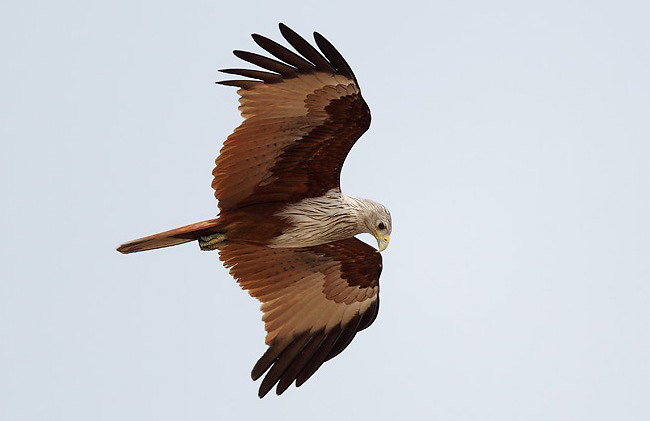
Brahminy Kite. One of the many spectacular birds easily seen at Goa. Image by Michael McKee.
India - Northern
Tiger, as well as spectacular birds such as Black-necked and Painted Storks, Indian Peafowl, Sarus Crane, Indian Skimmer, and Brown and Tawny Fish-owls,
especially at Bharatpur, one of the best birding sites in the world, and other animals including Asian Elephant and Gharial.
India - Northeastern
Seven Indian endemics restricted to this region, including Black-breasted Parrotbill, three wren-babblers and Bugun Liocichla, numerous near-endemics shared
with Nepal, Bhutan, China and Myanmar, including Ward's Trogon and Fire-tailed Myzornis, and other more widespread spectacular birds such as Himalayan
Monal, Rufous-necked Hornbill, Grandala, Himalayan Cutia and Beautiful Nuthatch, as well as Indian Rhinoceros, Asian Elephant, Hoolock Gibbon, Ganges River
Dolphin and even Tiger.
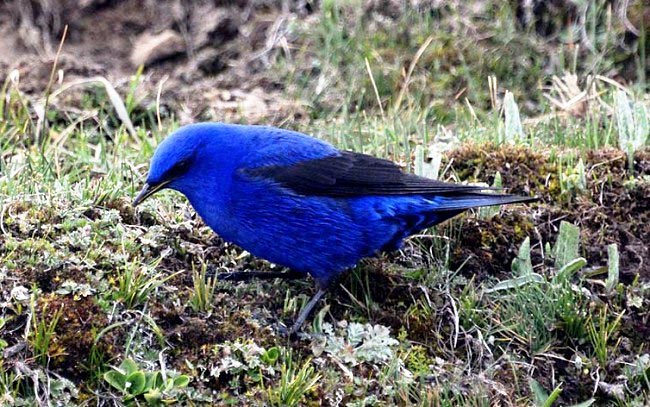
The beautiful Grandala, one of a flock which these birds usually occur in, by Jon Hornbuckle.
India - Northwestern
The best place in the world to look for Snow Leopards, in the high mountains of Ladakh.
India - Southern
Over 30 endemic birds based on the Western Ghats, including White-bellied Treepie, Flame-throated Bulbul, five laughingthrushes, two sholakilis (blue
robins), Black-and-orange Flycatcher and Crimson-backed Sunbird, over 30 birds shared only with Sri Lanka, such as Sri Lanka Frogmouth, Blue-faced Malkoha,
Sri Lanka Bay-owl, Malabar Trogon, Orange Minivet, Jerdon’s Leafbird and Loten’s Sunbird, and more widespread avian wonders like Indian Pitta and Indian
Blue Robin, as well as monkeys including Lion-tailed Macaque.
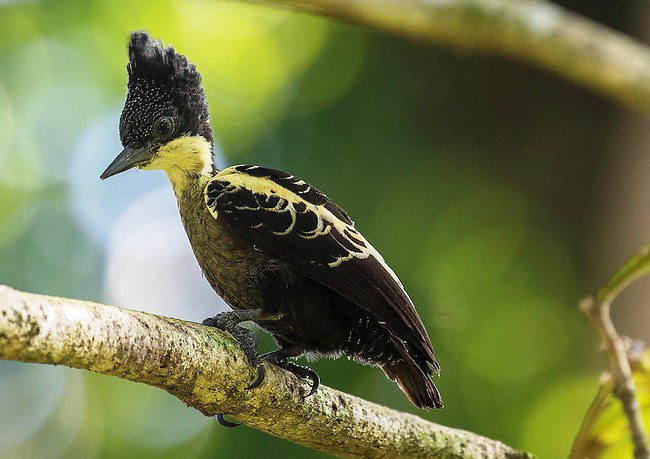
The tiny (16 cm (6 inches)) and extraordinary Heart-spotted Woodpecker at Thattekad in Southern India, by Francesco Veronesi.
India - Western
'Asiatic' Lion, Wild Ass, Blackbuck, a good chance of Leopard and Striped Hyaena, thousands of wintering Demoiselle Cranes, the largest harrier roost in
the world, flamingos, Crab Plover, Cream-coloured and Indian Coursers, and localized birds such as Hypocolius, White-bellied Minivet and Green
Avadavat.
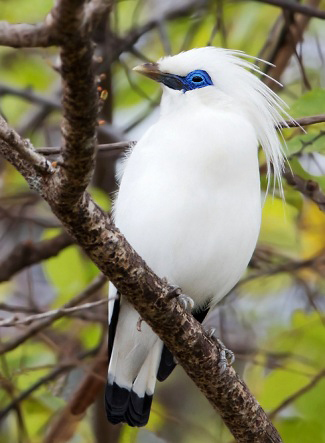
Bali Myna in Bali Barat National Park by Dubi Shapiro.
Indonesia - Bali
The numerous top birding destinations of Indonesia include the island of Bali, just across the narrow Bali Strait to the east of Java, where the very
rare and very beautiful white Bali Myna is being reintroduced (not very successfully) to Bali Barat National Park, where remnant open lowland deciduous
forest and coastal habitats also support Grey-rumped (Black-winged) Myna, Great-billed Heron, Javan Plover and Javan Banded Pitta.
Indonesia - Java
An extraordinary 40 endemic birds including a trogon, a broadbill and a cochoa, and another 28 species shared only with Sumatra and Bali, including Javan
Woodcock, Javan Kingfisher, Javan Banded Pitta and Java Sparrow, as well as Green Peafowl, Christmas Frigatebird and Blue Nuthatch, and some beautiful
mammals such
as Javan Gibbon, and leaf monkeys.
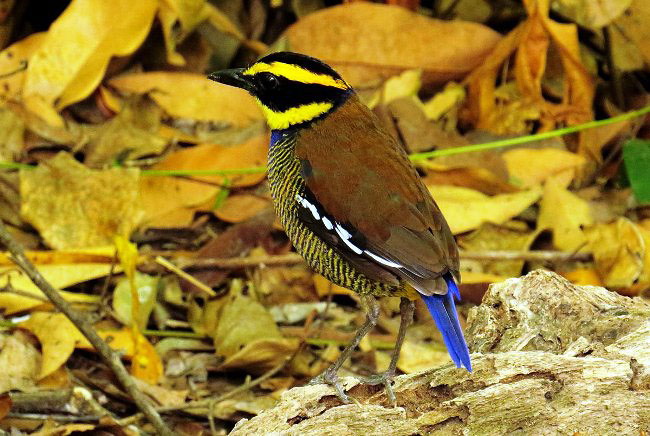
A 'Javan' Banded Pitta by Mark Harper.
Indonesia - Komodo
Komodo Dragons, rich coral reefs with Green Turtles and birds such as Yellow-crested Cockatoo and Flame-breasted Sunbird.
Indonesia - Lesser Sundas (Nusa Tenggara)
East of Bali, the islands of Lombok, Sumbawa, Komodo (where the world's largest lizard lives), Sumba, Flores, Alor, Wetar, Timor
(for East Timor see Timor/Timor-Leste, below) etc. in Wallacea support 95 endemic bird species,
including Sumba Buttonquail, Cinnamon-banded and White-rumped Kingfishers, Chestnut-backed and Orange-banded Thrushes, Black-banded Flycatcher,
Bare-throated Whistler and Flame-breasted Sunbird. The islands with the most endemics are Flores (6), Sumba (13), Timor (9), Wetar (5) and Rote (4). More
widespread spectacular species include Lesser Frigatebird, Green Junglefowl, Javan and Malay Plovers, Rainbow Bee-eater, Elegant Pitta and Pygmy Cupwing,
while the waters of the Flores and Banda Seas these islands lie in support Brown and Red-footed Boobies, Bridled and Sooty Terns, and Brown Noddy, as well
as cetaceans such as Blue, Bryde’s and Sperm Whales, and Bottlenose, Risso’s and Spinner Dolphins. The best time to look for birds is mid-August to
October.
At the far eastern end of the Lesser Sundas not far from Australia are the Tanimbar Islands in the Southern Moluccas (Maluku) where the 15 endemic birds include a scrubfowl (most likely on a small satellite island), a monarch and two thrushes. The main island Yamdena is accessible by air from Ambon.
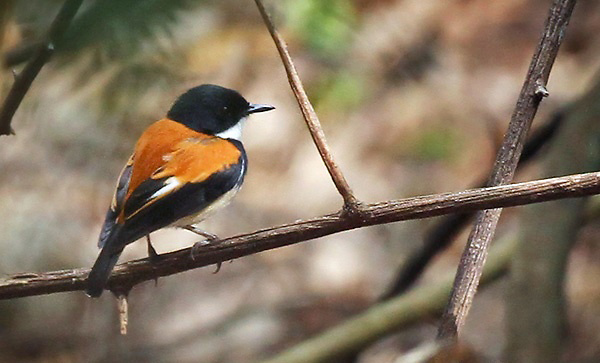
Black-banded Flycatcher, by Lars Petersson, a striking bird which occurs only on the island of Timor.
Indonesia - Moluccas (Maluku)
There are more than 100 endemic bird species in the Moluccas, of which 46 occur in the north on Halmahera and nearby islands, and 49 in the centre mainly
on Buru and Seram. North of Halmahera is the island of Morotai with three endemics; a pitta, a friarbird and a white-eye.
Halmahera is the best place to see most of the North Moluccas endemics including Azure Dollarbird (Purple Roller), Blue-and-white and
Sombre Kingfishers, White Cockatoo, Ivory-breasted Pitta, Halmahera Paradise-crow and Wallace's Standardwing but has only four single-island endemics;
Drummer (Invisible) Rail, Halmahera Oriole, Halmahera Cicadabird and Halmahera Golden Bulbul. For more information see
Indonesia - Sulawesi and Halmahera. To the south are the islands of Bacan with one endemic
and Obi with seven; an imperial-pigeon, a fruit-dove, a myzomela, a whistler, a fantail, a paradise-crow and a bulbul, although the island
races of Variable Goshawk, Spangled Drongo, Moluccan Monarch, Cream-throated White-eye and Common Cicadabird may all be considered to be full species one
day. However, Obi’s star avian attraction for many is the woodcock known only from Obi and a single specimen collected on Bacan.
In the Central Moluccas the island of Buru supports 20 endemics including a racquet-tail and a very strange bird called Madanga. Formerly known as Rufous-throated Dark-eye it is now placed in the pipit family although it lives in montane elfin forest and climbs up and down tree trunks! The rare Buru endemics, including Madanga, survive in remnant mountain forests as usual and include a mountain-pigeon, a lorikeet, a parrot, a honeyeater and a thrush. To the east is the long island of Seram with a forested mountainous spine within the Manusela National Park which supports the vast majority of the 17 endemics including a masked-owl and the rare Purple-naped Lory (also possibly on Ambon), while other species present on the island include Salmon-crested Cockatoo, Lazuli Kingfisher and Papuan (Blyth’s) Hornbill. The small mountainous island of Ambon next to Seram is the regional hub for visiting the Central and Southern Moluccas including the adjacent island of Haruku which has one of the best protected breeding sites for Moluccan Scrubfowl. At the southeastern corner of the Moluccas west of the Aru Islands near New Guinea are the Kai Islands where remnant forest patches hold four endemics; a coucal, a fantail, and Pearl-bellied (Great Kai) (on Kai Besar) and Golden-bellied (Little Kai) (on Kai Cecil and Dulah) White-eyes. The peak time to look for the birds of the Moluccas is August.
Indonesia - Sulawesi and Halmahera
Some of the world’s most spectacular birds occur on these islands where there are 86 endemics on Sulawesi and its satellites, and over 50 North Moluccas
endemics on Halmahera, including, on Sulawesi, Maleo, Heinrich’s (Diabolical/Satanic) Nightjar, Yellow-billed Malkoha, Blue-faced and Snoring Rails,
Sulawesi Woodcock, six owls, the colourful Knobbed Hornbill, Purple-bearded Bee-eater, Purple-winged Roller, six kingfishers, two racquet-tails, a pitta,
Piping Crow, Malia, Geomalia, six starlings and mynas, two thrushes, two hylocitreas (formerly a whistler, now in a family of their own) and three
flowerpeckers, and on Halmahera, Azure Dollarbird (Purple Roller), Sombre Kingfisher, White Cockatoo, Ivory-breasted Pitta, Halmahera Paradise-crow and
Wallace's Standardwing. These islands, especially Sulawesi, also support several striking mammals, not least macaques and tarsiers, and are surrounded by
some of the richest coral reefs on Earth.
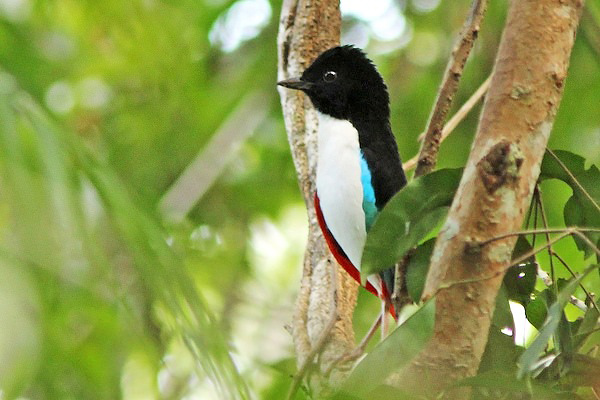
The amazing Ivory-breasted Pitta at Foli on the island of Halmahera by David Beadle.
Indonesia - Sulawesi's satellites
The largely deforested island of Sangihe lies in the Celebes Sea between Sulawesi and the island of Mindanao in the Philippines.
Accessible from Manado on Sulawesi, it supports eight endemic birds; some, like the scops-owl, hanging-parrot and sunbird, are widespread but it is
necessary to climb Gunung Sahendaruman to stand a chance of seeing the very rare Cerulean Paradise-flycatcher, as well as the whistler, the critically
endangered Sangihe Golden Bulbul and the virtually unknown endemic white-eye. Ruddy Kingfisher, a race of Western Hooded Pitta and Sangihe Tarsier also
occur on this island. To the east is the island of Talaud where there are five endemics; a rail, a bush-hen, a kingfisher, a lory and
a pitta, which occur along with Philippine Scrubfowl, Nicobar Pigeon, Malay Night-heron, Southern Rufous Paradise-flycatcher and three of the world's
four Tanygnathus parrots; Great-billed, Blue-naped and Blue-backed (the other one, Black-lored, is endemic to Buru). The best time to visit these islands
is April to September.
At Bunta on the north coast of Sulawesi’s ‘middle arm’ it is possible to charter a boat out to the island of Batudaka, the largest of the Togian (Togean) Islands, where it is possible to see the three endemics; a boobook, a golden bulbul and a white-eye.
The island of Peleng in the Banggai Islands south of Sulawesi’s ‘middle arm’ is accessible by boat from Luwuk, reached by air from Makassar (Ujung Pandang) at the south end of Sulawesi. All five Banggai endemics occur on this island; the fruit-dove, scops-owl, crow, golden bulbul and jungle-flycatcher, and the seven species restricted to Banggai and Sula; Sula Scrubfowl, Sula Cuckoo-dove, Sula Hanging-parrot, Sula Pitta, Slaty Cuckooshrike, Helmeted Myna and Red-and-black Thrush, as well as a possible new species of leaf-warbler and Peleng Tarsier. From Peleng it is possible to charter a boat to get to the well-forested island of Taliabu in the Sula Islands where, apart from the species shared with the Banggai Islands, there are ten endemics: Sula Fruit-dove, Taliabu Masked-owl, Sula Scops-owl, Sula Dwarf-kingfisher, Yellow-and-green Lorikeet, Sula Cicadabird, Taliabu Fantail, Sula Golden Bulbul, Bare-eyed Myna and Sula Jungle-flycatcher, as well as potential new species of locustella and leaf warblers in the high mountains. The peak time to visit the islands above is mid-November to mid-December.
Indonesia - Sumatra
The 30 mainland endemic birds include three partridges, two pheasants, a frogmouth, a ground-cuckoo, a trogon, two pittas, two wren-babblers, a mesia, a
cochoa and two leafbirds, and there are 12 more endemics on offshore islands. Other spectacular birds include White-winged Duck, Fire-tufted Barbet,
Malay Banded Pitta, Blue Nuthatch and Temminck's Sunbird, and there is a wide variety of mammals too, including Siamang, White-handed Gibbon and a chance
of Orang-utan off the beaten birding track.
Indonesia - West Papua
See West Papua, below.
Iran
Iran is a largely hot, dry and barren country but the Zagros Mountains rise to 12,000 ft (3600 m) and the highest peaks are permanently snow covered. The
many great birds include the endemic Iranian (Pleske's) Ground-jay which can be seen in the Dasht-e-Kavir Desert in the northeast. There are also a few
regional endemics and specialities such as Socotra Cormorant (south), Sind Woodpecker (southeast), Hypocolius (southwest), (Mesopotamian) Hooded) Crow
(southwest), Afghan (Common) (south) and Iraq (southwest) Babblers, Caspian Tit (north), Black-headed Penduline-tit (north) and Basra Reed-warbler
(southwest), plus White-headed Duck, Indian Pond-heron, Caspian Snowcock, See-see Partridge, Crab Plover, White-tailed Lapwing, Great Thick-knee,
Cream-coloured Courser, Indian Roller, several larks and wheatears, White-throated Robin, Eversmann's Redstart, Bay-backed Shrike, Asian Desert and
Menetries's Warblers, Streaked Scrub-warbler, Radde's Accentor, Purple Sunbird, Dead Sea Sparrow and Eurasian Crimson-winged Finch, as well as a chance of
Asian (Macqueen's) Houbara Bustard. The best time to look for birds is April-May. Mammals include Asian Wild Ass, Mouflon, Ibex (Wild Goat), Golden Jackal,
Goitered Gazelle, Chinkara (Indian Gazelle), Afghan Pika, various jerboas, Indo-Pacific Humpback (Plumbeous) Dolphin (from boat trips to and from Hormoz
Island in the Persian Gulf) and Black Finless Porpoise. About fifty (Asiatic) Cheetahs are thought to survive in the deserts, mainly around Dasht-e Kavir
in the northeast, but like (Persian) Leopard, Caracal, Striped Hyaena, Wolf, (Syrian) Brown Bear, Pallas's and Sand Cats, and Blanford's and Ruppell’s
Foxes, they are rarely seen by visitors. The 'flower fields' near Chelgerd with their vast swathes of wild Crown Imperials are famous amongst botanists as
are the country's colourful Dionysias and irises, amongst a fine flora best viewed during the middle two weeks of April.
Israel
A migration bottleneck for millions of birds, especially storks, raptors, shorebirds, pipits and warblers, and many localized Western Palearctic rarities
such as Asian Houbara (Macqueen’s) Bustard, Pallas's (Great Black-headed) Gull, Blackstart, Tristram’s Starling and Dead Sea Sparrow, with a chance of
others including Desert Tawny (Hume’s) Owl and Arabian Warbler.
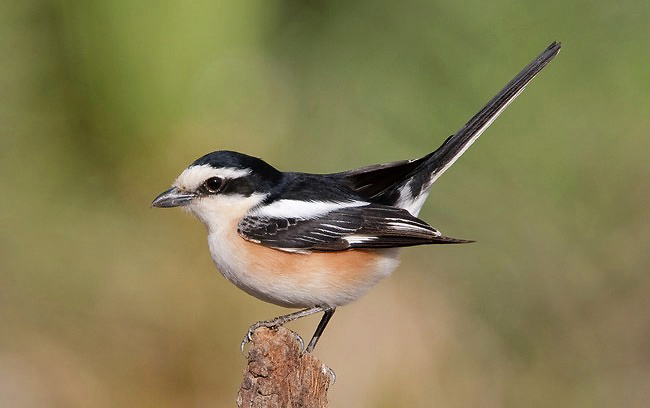
The smart Masked Shrike is a regular spring migrant in Israel. Image by Michael McKee.
J
Japan
‘Snow Monkey’ (Japanese Macaque), hundreds of Steller’s Sea-eagles, Red-crowned Cranes ‘dancing’ in the snow, thousands of Hooded and White-naped Cranes,
Baikal Teal and Blakiston's Fish-owl in the depth of the snowy northern winters, and, on the smaller southern islands, 17 of the 20 endemics, including
Okinawa Rail, Amami Woodcock, Amami (Lidth's) Jay, Ryukyu Robin, Iriomote Tit and Izu Thrush, as well as summer visitors such as Ruddy Kingfisher, Fairy
Pitta and Japanese Paradise-flycatcher.
Java
See Indonesia - Java, above.
Jordan
Like Israel to the west Jordan lies on a migration bottleneck which sees the passage of an estimated 500 million birds of about 300 species, especially
raptors, storks and passerines, and supports some localised landbirds and Western Palearctic rarities such as Sand Partridge, White-eyed Gull, Namaqua Dove,
Desert Tawny (Hume's) Owl (most likely at the famous ancient city of Petra), Blackstart, Buff-rumped, Desert, Hooded, Mourning and White-crowned Wheatears,
Arabian Babbler, Greater Hoopoe-lark, Arabian (Dunn's), Bar-tailed and Temminck’s Larks, Masked Shrike, Arabian Warbler, Streaked Scrub-warbler,
White-spectacled Bulbul, Tristram’s Starling, Palestine Sunbird, Desert Finch, Dead Sea Sparrow, Syrian Serin, Sinai Rosefinch and Striolated Bunting, with
a chance of Brown Booby, Pharaoh Eagle-owl and Cyprus Wheatear, as well as more widespread birds including Spur-winged Lapwing, Little Crake,
White-breasted (Smyrna) Kingfisher, Arabian Green Bee-eater, Pale Rock Martin, Graceful Prinia, Moustached Warbler, and Brown-necked and Fan-tailed Ravens.
Mammals include Nubian Ibex. Spring bird migration usually lasts from March to May and peaks from mid-March to early April which also happens to usually be
the best time for most flowers including the national flower the Black Iris. Actually there are five black Irises, as well as Blue, Purple and White ones,
and other spectacular flowers include blue and lilac-pink Lupins.
K
Kai Islands
See Indonesia - Moluccas, above.
Kazakhstan
There are some very special birds to be seen on a trip to Kazakhstan combined with Turkmenistan and Uzbekistan in the Central Asian area known as Turkestan,
including Himalayan Snowcock, Yellow-eyed Pigeon, Asian Houbara (Macqueen’s) Bustard, Demoiselle Crane, Sociable Lapwing, Black-winged Pratincole,
Ibisbill, Pallas’s Sandgrouse, White-winged Woodpecker, Turkestan (Pander's) Ground-jay, Azure Tit, Black and White-winged Larks, White-browed Tit-warbler,
Eversmann's Redstart, Himalayan Rubythroat, Black-throated Accentor, Saxaul and Zarudny's (Desert) Sparrows, Red-mantled Rosefinch and Red-headed Bunting,
as well as mammals such as Great Gerbil.
Komodo - Indonesia
See Indonesia - Komodo, above.
Korea - South
See South Korea, below.
Kuwait
This tiny land of sand lies on a migrant flyway where the passage of birds usually peaks from mid-March to early May (especially early April) and in
November and can be good enough at least as far as passerines are concerned during the spring to rival more famous destinations for observing migrating
birds such as Eilat in Israel. In addition, Kuwait is situated at the south-eastern extremity of the Western Palearctic and, depending on the season, the
best place in the region for Western Palearctic listers to look for the likes of Socotra Cormorant (spring), Red-wattled Lapwing, Indian Roller (winter),
Basra Reed-warbler (spring), Afghan Babbler and Hypocolius (winter, when there are regular roost sites or pre/post-roost gatherings). During the spring it
is also possible to see Levant Sparrowhawk, Shikra, White-cheeked Tern, Egyptian Nightjar, Blue-cheeked Bee-eater, Arabian (Dunn’s) Lark, Black-crowned
Sparrow-lark, Menetries’s and Upcher’s Warblers, Semi-collared Flycatcher, Pale Sparrow and Cinereous Bunting. During the winter there are usually good
numbers of waterbirds in Sulaibikhat Bay including Greater Flamingo, Crab Plover, Broad-billed and Terek Sandpipers, and Greater and Lesser Sandplovers,
while in the desert some ‘oases’ such as Jahra Pools Reserve support Greater Spotted and Eastern Imperial Eagles, Grey-headed Swamphen, White-tailed
Lapwing, Pallas's (Great Black-headed) Gull, Pied and White-breasted (Smyrna) Kingfishers, Oriental Skylark, Red-tailed (Persian) Wheatear, White-eared
Bulbul, Clamorous Reed-warbler and Moustached Warbler. Unfortunately it is necessary to obtain permission well in advance to visit some of the best sites,
something best organised by a local, and a lot of people shoot birds, particularly during spring and autumn. June to August is not a good time to visit,
the summer being uncomfortably
hot.
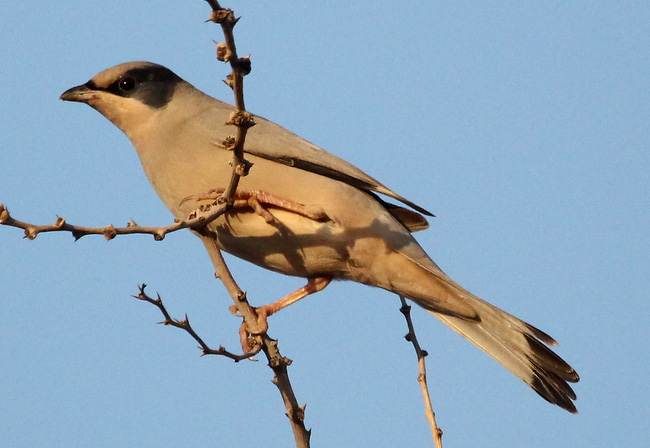
The unique Hypocolius in Kuwait in December by Spider.
Kyrgyzstan
This landlocked, open, wild country to the south of Kazakhstan dominated by the Tien Shan mountain range rising to 7439 m (24,406 ft) supports Himalayan
Snowcock, Lammergeier, Ibisbill, Hill Pigeon, White-winged Woodpecker, Isabelline Wheatear, Himalayan Rubythroat, Blue-capped, Eversmann’s and White-winged
(Güldenstädt's) Redstarts, Blue Whistling-thrush, Rufous-tailed Rock-thrush, White-browed Tit-warbler, Sulphur-bellied and Sykes’s Warblers, Rufous-naped
and (Yellow-breasted) Azure Tits, White-crowned Penduline-tit, Wallcreeper, Alpine, Altai, Black-throated and Brown Accentors, Rosy Starling, White-winged
Snowfinch, White-winged Grosbeak, Red-fronted Serin, Red-mantled Rosefinch, Mongolian Finch, Brandt’s (Black-headed) and Plain Mountain-finches, and
Grey-necked, Red-headed and White-capped Buntings. The best time for birds is the northern summer and the best birding sites include Ala-Archa National
Park, the May-Saz Valley area and Arslanbob.
L
Ladakh - Northwestern India
See India - Northwestern, above.
Laos
In this impoverished country, the only landlocked one in South East Asia, many birds, especially large ones, and other animals, are hunted and, as a
consequence, very shy. However, it is possible to see the sole endemic, Bare-faced Bulbul, near the village of Ban Na Hin in the karst limestone hills of
the Annamite mountain range in central Laos, as well as the near-endemics Red-collared Woodpecker and Sooty Babbler, plus Orange-breasted and
Red-headed Trogons, Black-capped and Ruddy Kingfishers, Blue-bearded Bee-eater, Green-eared Barbet, Pale-headed Woodpecker, Great Iora, Sultan Tit and
Black-browed Fulvetta, and there is a chance of Silver Pheasant, Spot-bellied Eagle-Owl, Long-tailed Broadbill, Blue-naped and Eared Pittas, Green Cochoa,
White-tailed Flycatcher and Rufous-throated Fulvetta, and an outside chance of Limestone Leaf-warbler and the endemic Lao Langur. There is virtually no
chance however of seeing Tiger, Leopard, Clouded Leopard, Asian Golden Cat and White-cheeked Gibbon which have also been recorded in this region, known as
the Nakai–Nam Theun National Biodiversity Conservation Area. Along the Mekong upstream from the capital Vientiane is a good area for Jerdon’s Bushchat, as
well as River Lapwing. For waterbirds head south to the Xe Pian area where Green Peafowl, White-winged Duck, Giant Ibis, Masked Finfoot and Sarus Crane
have been recorded, although more likely species include Cinnamon Bittern, Chinese Pond-heron, Pied Harrier, Bronze-winged and Pheasant-tailed Jacanas, and
Black-capped Kingfisher. At Don Khon, Small Pratincole, Chestnut-headed Bee-eater, Mekong Wagtail and Irrawaddy Dolphin are possible.
Lesser Sundas
See Indonesia - Lesser Sundas, above.
Lesvos
The Greek island of Lesvos is situated in the Aegean Sea to the east of mainland Greece, although it is actually next to the west coast of Turkey. It
is a very popular destination with birders during the northern spring when large numbers of a wide variety of birds migrate through the island,
including herons, Pallid Harriers, Eleonora's and Red-footed Falcons, Little Crakes, shorebirds including Collared Pratincoles, Whiskered and
White-winged (Black) Terns, European Rollers, Red-throated Pipits, Collared Flycatchers, warblers and shrikes. The numbers of passage migrant birds
usually peak in the second half of April which coincides with the usual arrival period of breeding summer visitors such as Short-toed Eagle, European
Bee-eater, Isabelline Wheatear, Rufous-tailed Scrub-robin (Rufous Bush Chat), Masked Shrike, Olive-tree, Eastern Orphean and Rüppell's Warblers, and
Black-headed, Cinereous and Cretzschmar's Buntings. These join resident species such as Ruddy Shelduck, Greater Flamingo, White and Black
Storks, Long-legged Buzzard, Sombre Tit, and Krueper's and Western Rock Nuthatches to make a fine selection of birds which may also include rarer
migrants such as Levant Sparrowhawk, Baillon's Crake, Spur-winged Lapwing and Great Snipe, while around the coast there is a chance of Audouin's Gull
(a rare resident) and offshore a better chance of Scopoli's (Cory's) and Yelkouan (Balearic) Shearwaters.
Leti
See Indonesia - Lesser Sundas, above.
M
Malaysia - Borneo
See Borneo, above.
Malaysia - Malay Peninsula
A long list of fabulous South-East Asian birds, especially trogons, kingfishers, bee-eaters, barbets, broadbills, hornbills, pittas and leafbirds with a
chance of Rail-babbler, primates such as Siamang and White-handed Gibbon, and even Malayan Tapir, in possibly the oldest lowland rainforest on Earth, at
Taman Negara.
Mongolia
Bird specialities such as Altai Snowcock, Black-billed Capercaillie, Demoiselle and White-naped Cranes, Pallas’s Fish-eagle, Oriental Plover, Relict Gull,
Pallas’s Sandgrouse, Mongolian (Henderson's) Ground-jay and Mongolian Accentor, and mammals including Siberian Ibex, Great Gerbil and an outside chance of
Snow Leopard, in vast grass steppes, the Gobi Desert and the Altai Mountains.
Morotai
See Indonesia - Moluccas, above.
Myanmar (Burma)
Myanmar (Burma) has 13 endemic bird species not including Gurney's Pitta which is almost extinct in Thailand; Burmese Collared-dove, Irrawaddy
(Black-and-red) Broadbill, Jerdon’s Minivet, Hooded Treepie, Burmese Bushlark, Burmese Prinia, Ayeyarwady, Grey-crowned and Pale-eyed Bulbuls, Burmese
(Black-browed) Tit, Naung Mung Wren-babbler, White-throated Babbler and White-browed Nuthatch. The minivet, treepie, lark and babbler occur on the plains
along the banks of the Irrawaddy River (‘the road to Mandalay’) near Bagan (along with the rare White-rumped Pygmy-falcon), and the tit and nuthatch not
far away in Natmataung (Mount Victoria) National Park near Kanpetlet in the Chin Hills, steep mountains which form a southern extension of the Himalayas,
where other birds very difficult to see elsewhere include (Buff-breasted) Black-throated and Spot-breasted Parrotbills, Mount Victoria (Chinese) Babax,
Spot-breasted Scimitar-babbler, Chin Hills (Long-tailed) Wren-babbler, Assam, Blue-winged, Brown-capped and Striped Laughingthrushes, Red-faced Liocichla,
Rusty-capped Fulvetta, Rusty-fronted and Streak-throated Barwings, Grey Sibia, White-bellied Redstart, Grey-sided Thrush (during the northern winter),
Black-bibbed Tit, Crested Finchbill and Brown Grasshopper-warbler, and more widespread goodies occur, such as Hodgson's Frogmouth, Black-eared,
Black-headed and Green Shrike-babblers, Himalayan Cutia, Red-tailed Minla, and Fire-tailed and Gould's Sunbirds. In the east the near-endemic Burmese
Yuhina can be seen near Kalaw in the hills of Shan State along with Black-tailed Crake, Pin-tailed Green-pigeon, Slender-billed Oriole, Sapphire Flycatcher,
Black-breasted Thrush, Martens’s Warbler (northern winter), Dark-backed Sibia and Collared Myna while Jerdon's Bushchat and Chinese Grass-babbler occur by
the huge, 45 square mile, shallow Inle Lake. Down south it is possible to see Spoon-billed Sandpipers on their wintering grounds; most of the remaining
population (perhaps less than 200) probably winters on the Myanmar coast. Another very rare bird, Gurney's Pitta, occurs in Tenasserim in the far south,
along with Blue-winged, Garnet and Malay Banded Pittas, and Plain-pouched Hornbill. The best time to search for pittas is mid-March to mid-April when they
are normally at their most vocal but seeing them will involve a organising a mini camping expedition from the coastal town on Myiek. Back in Yangon there
is a roost of half a million or so Asian Wrinkle-lipped Bats at the spectacular Shwedagon Pagoda. The best time for most birds 'up north' is November to
March.
N
Nepal
A small country packed with birds, more than any other region of comparable size in Asia, including Himalayan Monal, Satyr Tragopan, Ibisbill, the sole
endemic, Spiny Babbler, Slender-billed Babbler, the near-endemic Nepal Cupwing, Himalayan Cutia, Fire-tailed Myzornis, Grandala, Pied Thrush and Finn's
Weaver, as well as Indian Rhinoceros, Gharial and a chance of Tiger, in some of the most spectacular scenery on Earth.
Nepal - Hange Tham
Beautiful Himalayan oak-rhododendron forests where Red Panda is probable not possible!
O
Obi
See Indonesia - Moluccas, above.
Oman
A chance of Hypocolius, and other localized birds such as Jouanin's Petrel, Sooty Falcon, Omani Owl, Hume's Wheatear, Arabian (Golden-winged) Grosbeak and
Yemen Serin, as well as more widespread spectacular birds including Red-billed Tropicbird, Lappet-faced Vulture, Steppe and Verreaux’s Eagles, Crab Plover,
Indian Roller, all in a country with a long coastline, deserts and the highest mountain in the Middle East.
P
(Western) Pacific Odyssey
See Western Pacific Odyssey, below.
Pakistan
Pakistan would surely be a popular birding destination without so many mainly political and religious troubles, and what a country to go birding in,
especially the north where the Pamirs, Hindu Kush, Himalayas and Karakoram Ranges meet and numerous spectacular mountains rise to 8611 m (28,251 ft)at K2,
the second highest mountain on Earth, just 237 m (778 ft) lower than Everest. The barren scree slopes, high meadows, coniferous and mixed forests, and
rushing rivers support an exciting range of Western Himalayan Endemic (or breeding-endemic) specialities such as Brooks’s and Tytler’s Leaf-warblers,
White-throated Tit, Kashmir Nuthatch, Spectacled Finch and Orange Bullfinch, as well as Indian Blue Robin, Blue-capped, Blue-fronted and White-bellied
Redstarts, Streaked Laughingthrush, Yellow-billed Blue Magpie, Rufous-breasted Accentor, rosefinches and White-capped Bunting. A good place to look for
these birds is the scenic Kaghan Valley which runs north from the town of Balakot, north of Abbottabad. North of there, along the Karakoram Highway to
Gilgit roadside birds include Hume’s and Variable Wheatears, Tickell’s Thrush and the migratory bactrianus race of House Sparrow. Near Gilgit lies the
Naltar Valley which supports breeding Long-billed Grasshopper-warbler, Sulphur-bellied Warbler, Larger-spotted Nutcracker and Blyth’s Rosefinch, as well as
White-browed Tit-warbler. Back south the virtually endemic White-cheeked Tit can be seen in the Margalla Hills near Islamabad. One of the country’s star
birds, Western Tragopan, has its stronghold in the remote Palas Valley northwest of Abbottabad, and it also occurs in the Neelum Valley of Azad Kashmir
next to northwest India, along with Cheer and Koklass Pheasants, Kashmir Flycatcher, Kashmir and White-cheeked Nuthatches, Black-headed Jay and Orange
Bullfinch. Through the mountainous north from Tibet flows the mighty Indus and it continues south through the whole of the country to near Karachi on the
south coast, providing water for the Punjab’s agricultural plains, and lakes of great importance to waterbirds including Greater Flamingos and Pallas’s
Fish-eagles. In the deserts of the southwest there seven species of sandgrouse; Black-bellied, Chestnut-bellied, Crowned, Lichtenstein's, Painted,
Pin-tailed and Spotted. Wetlands near Karachi support breeding Pallas’s Fish-eagle, and wintering Dalmatian and Great White Pelicans, and at Hab Dam and
Valley about 30 km north of the city it is possible to see Hypocolius. The best time to visit the north is between May and September, early June for the
majority of breeding species. It is hot all year round in the centre and south, especially in June and July.
Pantar
See Indonesia - Lesser Sundas (Nusa Tenggara), above.
Peleng
See Indonesia - Sulawesi's satellites, above.
Philippines
Over 260 endemic birds in a country archipelago slightly smaller than the British Isles, including Palawan Peacock-pheasant, Philippine (Monkey-eating)
Eagle, Philippine Trogon, 11 kingfishers, 11 hornbills, two broadbills, three pittas, four rhabdornises (a unique genus in the starling family), 13
sunbirds and 15 flowerpeckers,a s well as Philippine Tarsier, and the chance to swim with Dugongs, Manta Rays, Whale Sharks and numerous coral reef
fish.
Poyang Hu - China
See China - Eastern (Poyang Hu), above.
R
Russia - Arctic
The richest tundra in the world where hundreds of thousands of swans, geese, ducks, shorebirds, seabirds and other waterbirds nest including Spoon-billed
Sandpiper, Siberian Crane, Ross’s and Sabine’s Gulls, Emperor Goose, and Spectacled and Steller’s Eiders, as well as Gyr Falcon, and Hawk and Snowy
Owls.
Russia - Kamchatka, and the Kuril and Commander Islands
Some of the world's most spectacular seabird colonies, with Horned and Tufted Puffins, and Crested, Parakeet and Whiskered Auklets, other spectacular
birds such as Laysan Albatross and Steller's Sea-eagle, numerous fur seals and sealions, forming one of the greatest concentrations of marine mammals on
Earth, Brown Bears and the chance of Blue, Killer and Sperm Whales.
S
Sangihe
See Indonesia - Sulawesi's satellites, above.
Saudi Arabia
The Kingdom of Saudi Arabia is on a migratory flyway and serves as an important resting and refueling stopover for birds moving between Europe, Asia and
Africa. In the east spring migration occurs between mid-February and mid-May usually peaking in April and autumn migration occurs between mid-August and
early November but is less heavy than the spring migration. In the southwest 15 of the 16 Arabian endemic bird species are present; Arabian (Red-legged)
and Philby's Partridges, Arabian (African) Scops-owl, Arabian Woodpecker, Asir Magpie, Yemen Warbler, Yemen Thrush, Arabian and Buff-breasted Wheatears,
Arabian (Shining) Sunbird, Arabian Golden-winged Grosbeak, Arabian Waxbill, Arabian and Yemen Serins, and Yemen Linnet. The only one missing is Yemen
(Radde's) Accentor which is endemic to Yemen. All 15 can be seen in the Abha area of the Asif mountains, connected by air to both Jeddah and Riyadh. Also
present in this region are Arabian Green Bee-eater, Streaked Scrub-warbler, Arabian Warbler, Blackstart, Arabian Golden Sparrow, and Nile Valley and
Palestine Sunbirds, mainly Afrotropical species such as Hamerkop, Spotted Thick-knee, Sooty Gull, Bruce’s Green-pigeon, Grey-headed Kingfisher,
White-throated Bee-eater, Abyssinian Roller, African Paradise-flycatcher and Black Scrub-robin, and, along the Red Sea coast, Crab Plover, and Saunders’s
and White-cheeked Terns.
Seram
See Indonesia - Moluccas, above.
Sichuan - China
See China - Sichuan, above.
Singapore
Singapore is an island city and country, the second most densely populated (behind Monaco) on the planet and yet it is possible to see some very good
birds in this metropolis. Changi International Airport is a massive transit point for people travelling between Southeast Asia, Indonesia and Australasia
and any birders with more than a couple of hours to spare may wish to consider visiting Pasir Ris Park and the Botanic Gardens. Pasir Ris is a small park
with a mangrove boardwalk and bird-viewing tower where it is possible to see, in season, Mangrove Pitta, Black-capped and Collared Kingfishers,
Blue-throated Bee-eater, Laced Woodpecker, Asian Glossy Starling and Copper-throated Sunbird. The botanic gardens are usually very busy with people but it
is still possible to see birds such as Red-legged Crake, Stork-billed Kingfisher and Lineated Barbet, as well as Yellow Bittern, Pink-necked Green-pigeon
and Crimson Sunbird. Not far from the botanic gardens is Bukit Batok Nature Park where Straw-headed Bulbul occurs. In order to leave the airport during
transit passengers will need (i) to request a landing card on-board and present it to immigration on arrival, and (ii) some Singaporean dollars to pay for
taxis, trains and so on. Many birders stay longer, to visit Panti Forest Reserve, 90 minutes or so north in peninsular Malaysia, lowland dipterocarp
rainforest which supports Rail-babbler, as well as Blyth’s Frogmouth, Malay Eared Nightjar, malkohas, Whiskered Treeswift, Rufous-collared Kingfisher,
trogons, hornbills, woodpeckers, Siberian Blue Robin, babblers, broadbills, bulbuls, White-handed Gibbon, and Banded and Dusky Leaf
Monkeys.
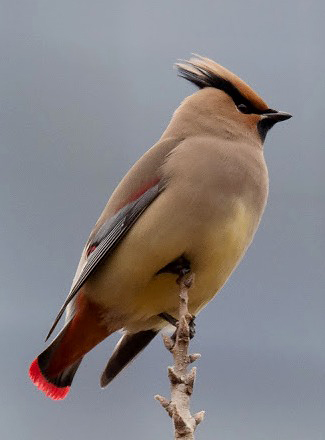
Japanese Waxwing is a winter visitor to South Korea where this image was taken by Simon Colenutt.
South Korea
This small country - slightly smaller than England - is almost as exciting for birds during the cold winters as Japan to the east what with such rare and
range-restricted species as Swan Goose, Falcated and Mandarin Ducks, Baikal Teal (not always present but sometimes in huge flocks), Scaly-sided Merganser,
Oriental Stork, Steller's Sea-eagle, Hooded, Red-crowned and White-naped Cranes, Solitary Snipe, Relict and Saunders's Gulls, Spectacled Guillemot, Ancient
and Long-billed Murrelets, Japanese Pygmy Woodpecker, Japanese Wagtail, Japanese Waxwing, Red-throated Thrush, Varied Tit and lots of buntings including
Pallas's. The best area for cranes is usually Cheorwon where the vast majority forage in the Civilian Control Zone, an area used for farming only and
accessible only with local guides or on local organized tours since it is next to the completely undeveloped Demilitarized Zone on the border with North
Korea. During the summer, after late May-early June, it is possible to see Fairy Pitta in South Korea.
Sri Lanka
Over 30 endemic birds and over 30 shared only with Southern India, including a junglefowl, a frogmouth, two malkohas, a trogon, two flameback woodpeckers,
a blue magpie, a scimitar-babbler, two thrushes and a leafbird, some fabulous wintering birds hard to see elsewhere such as Indian Pitta, Pied Thrush,
Indian Blue Robin and Kashmir Flycatcher, Leopards, lorises, monkeys and a good chance of 'Pygmy' Blue Whale, all based on an island just 434 km (270 miles)
by 225 km (140 miles).
Sula Islands
See Indonesia - Sulawesi's satellites, above.
Sulawesi and Halmahera
See Indonesia - Sulawesi and Halmahera, above.
Sulawesi's satellites
See Indonesia - Sulawesi's satellites, above.
Sumatra
See Indonesia - Sumatra, above.
T
Taiwan
This small, mountainous, subtropical island, less than 400 km (250 miles) long and 150 km (100 miles) wide, in the South China Sea, supports 30 endemic
bird species and rising as taxonomists continue to split island forms of widespread species into full species and on Taiwan there are about forty more
endemic subspecies! The endemics are Taiwan Partridge, Taiwan Bamboo-partridge, Mikado and Swinhoe’s Pheasants, Taiwan Barbet, Taiwan Blue Magpie,
Chestnut-bellied (Varied) and Yellow Tits, Taiwan Cupwing, Taiwan Grasshopper-warbler, Styan’s Bulbul, Taiwan Yuhina, Black-necklaced and Taiwan
Scimitar-babblers, Grey-cheeked and Taiwan Fulvettas, Taiwan Hwamei, Rufous-crowned, Rusty and White-whiskered Laughingthrushes, White-eared Sibia, Taiwan
(Steere’s) Liocichla, Taiwan Barwing, Taiwan Thrush, Small Vivid Niltava, Taiwan Shortwing, Collared Bush-robin, Taiwan Whistling-thrush, Flamecrest and
Taiwan Rosefinch, while the endemic subspecies include Northern (Eurasian) Nutcracker (owstoni), Maroon Oriole (ardens), Golden Parrotbill (morrisoniana)
and Collared Finchbill (cinereicapillus). Other notables are headlined by the beautiful Fairy Pitta (in the western lowlands) but they also include Malay
Night-heron (which like the pitta is easier to see on Taiwan than anywhere else, even in Taipei Botanical Gardens), Chinese Egret, Black-faced Spoonbill
(hundreds winter in the lowland wetlands of the southwest and many stay on until April) and Japanese Paradise-flycatcher (most likely on the island of
Lanyu). Mammals such as Taiwanese (Rock) Macaque, Taiwan Serow, and Indian Giant Flying and Red-and-white Flying Squirrels are also possible, and other
natural wonders include Taroko Gorge, a narrow chasm with vertical marble walls. The peak time to visit is the second half of April when newly-arrived
Fairy Pittas are most likely to be located although rain and mist are to be expected at this time of the year. July is the peak time to try and see the
endangered Chinese Crested Tern in the Matsu Archipelago accessible by air from Taipei. Due to the rapidly increasing popularity of bird photography across
Asia, be prepared to see some birds in zoo-like conditions, at photographers' 'stake-outs' often complete with screens and many photographers.
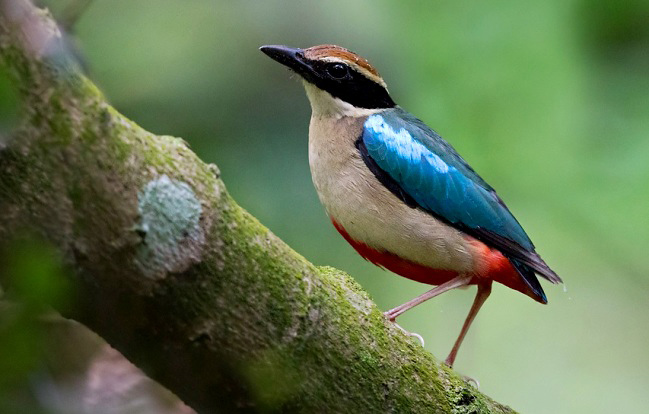
The rare Fairy Pitta near the village of Huben on the island of Taiwan by Lars Petersson.
Tajikistan
This landlocked country, the smallest in central Asia, lying north of Afghanistan, dominated by the Pamir mountain range and rising to 7495 m (24,590 ft)
is sprinkled with spectacular anemones, irises, tulips and so on during the first half of April, not the best time for birds which is late May to early
June when it is possible to see Himalayan Snowcock, Lammergeier, Hill Pigeon, White-winged Woodpecker, Streaked Laughingthrush, Rusty-tailed Flycatcher,
Himalayan Rubythroat, Blue-capped and White-winged (Güldenstädt's) Redstarts, Plumbeous Water-redstart, Variable Wheatear, White-browed Tit-warbler,
Large-billed Reed-warbler (riparian scrub along Panj River near Khorog, the main town in the Pamir mountain range), Sulphur-bellied Warbler,
(Yellow-breasted) Azure Tit, Eastern Rock Nuthatch, Wallcreeper, Great Rosefinch, Plain Mountain-finch, White-winged Grosbeak and White-capped Bunting.
Good birding sites include Iskender Kul, a large alpine lake at 2195 m (7200 ft) north of the capital Dushanbe in the Fann mountain range. Farther
afield the Pamirs are home to Markhor (Darwaz Mountains near border with Afghanistan), Marco Polo Sheep, Ibex, Urial Sheep and Snow Leopard which is most
likely to be seen during the winter when they venture lower down, but all large animals are very shy due to hunting.
Talaud
See Indonesia - Sulawesi's satellites, above.
Taliabu
See Indonesia - Sulawesi's satellites, above.
Tanimbar Islands
See Indonesia - Lesser Sundas, above.
Thailand - Northern
Northern Thailand is very different from the rest of the country. Mountain ranges support a more Himalayan avifauna and montane specialities at sites such
as Doi Chiang Dao, Doi Ang Khang, Doi Inthanon and Doi Lang include Mrs Hume’s Pheasant and Giant Nuthatch, as well as Rufous-naped Pitta, Crested
Finchbill, Scarlet-faced Liocichla and Spot-breasted Parrotbill. There is even a chance of Black-tailed Crake, Hodgson's Frogmouth (most likely in April)
and Green Cochoa while other spectacular species present include Collared Falconet, Blossom-headed Parakeet, Black-headed Woodpecker, Long-tailed and
Silver-breasted Broadbills, Rufous Treepie, Common Green Magpie, Slaty-bellied Tesia, Silver-eared Mesia, Pygmy Cupwing, Spot-winged Grosbeak, and Gould's
and Green-tailed Sunbirds (endemic angkaensis subspecies on Doi Inthanon). Some birds, especially shy, skulking, ground-dwelling, forest birds are much
easier to see than they once were thanks to the popularity of bird photography in East Asia; the photographers have set up 'feeding stations' where
mealworms are provided. In the lowlands nearby it is possible to see the rare Green Peafowl at Huai Hong Khrai. December to March is the best time to
visit, when resident species are joined by wintering birds from northeast Asia.
Thailand - Southern
Spectacular localized birds such as Siamese Fireback, Coral-billed Ground-cuckoo, Nicobar Pigeon, Malay Banded Pitta and Rail-babbler, wintering shorebirds,
not least Spoon-billed Sandpiper and Spotted Greenshank, and a long list of fabulous South-East Asian birds including trogons, kingfishers, bee-eaters,
barbets, broadbills, pittas, hornbills, leafbirds, babblers and sunbirds, as well as the chance of White-handed Gibbon.
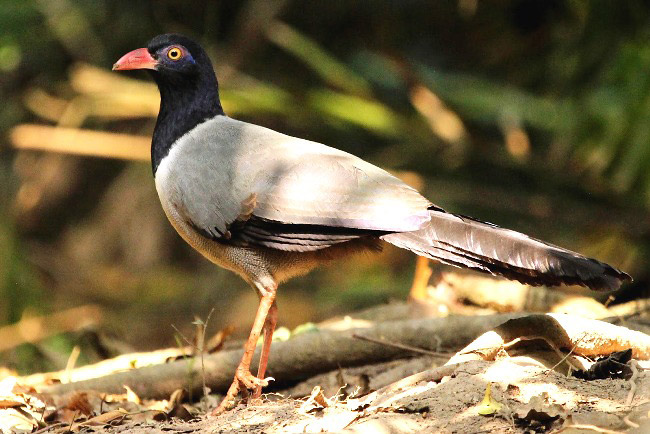
An extraordinary Coral-billed Ground Cuckoo in Khao Yai National Park, Southern Thailand, by Spider.
Tibet
Rare high-altitude birds including Przevalski’s Rosefinch or Pinktail, which is in a family all of its own, Blue and Tibetan Eared-pheasants, Black-necked
Crane, Tibetan Sandgrouse, Snow Pigeon, Ala Shan Redstart, Crested and White-browed Tit-warblers, Ground Tit, Giant Babax, snowfinches, rosefinches and
Tibetan Bunting, with more widespread spectacular species such as Bar-headed Goose, Lammergeier, Ibisbill, Pallas’s Sandgrouse and Wallcreeper, and mammals
such as Tibetan Wild Ass and a chance of wild Yak and 'Tibetan' Wolf, all in some phenomenal scenery, on and around the rolling plains of the Tibetan
Plateau, average height 4500 m (15,000 ft)!
Timor/(Democratic Republic of) Timor-Leste
The island of Timor is the largest and geographically most ancient of the Lesser Sundas islands of eastern Indonesia although the lowland forests and
scrub resemble northern Australia which is not far away to the south. There are nine birds endemic to this island; a boobook, two honeyeaters, a friarbird,
a myzomela, a bushbird, a white-eye, a flycatcher and a flowerpecker, and a lot more shared with neighbouring islands such as Alor, Rote and Wetar
including a stubtail, a blue-flycatcher, a bushchat and a thrush. It is usually possible to see most endemics and near-endemics in West Timor (Indonesia)
but Timor Green-pigeon and Iris Lorikeet are more likely to be seen in the east because they are so heavily hunted in the west, and the endemic race of
Pheasant Coucal occurs only in East Timor. The lorikeet occurs in the hills above the capital Dili along with Olive-headed Lorikeet, Yellow-crested
Cockatoo, Timor Imperial-pigeon, Timor Stubtail, Buff-banded Bushbird, Flame-eared Honeyeater, Black-breasted Myzomela, Spot-breasted and Warbling
White-eyes, and Timor Flowerpecker. Nino Konis Santana National Park at the far eastern end of the island is the place for Timor Green-pigeon and Pheasant
Coucal, as well as Yellow-crested Cockatoo (the park probably supports the largest remaining population of this critically endangered bird), Black
Cuckoo-dove, Timor Boobook, Cinnamon-banded Kingfisher, Black-banded Flycatcher, Timor Blue-flycatcher, Timor Stubtail, Timor Oriole, Timor Figbird and
Flame-breasted Sunbird. Water bodies such as Lake Iralalaro support many Australasian species such as Australasian Darter, Pied Heron and Rainbow
Bee-eater, as well as Saltwater Crocodiles.
Togian (Togean) Islands
See Indonesia - Sulawesi's satellites, above.
Turkey
Some of the most exciting birding in the Western Palearctic, but Turkey is a huge country and to see all of its best birds it would be necessary to
travel hundreds of miles, so most visitors opt to cover certain areas. The Bosphorus, especially in September, is a great place to watch the visible
migration of tens of thousands of raptors including Lesser Spotted Eagles and Levant Sparrowhawks, along with huge numbers of White Storks and some
Black Storks, on their way from Eurasia to Africa. The narrow strait between Europe and Asia is also regularly traversed by Yelkouan (Balearic)
Shearwaters. In southwest (as well as southern and eastern) Turkey it is possible to see the likes of Dalmatian Pelican (Lake Karine near Bafa),
Spur-winged Lapwing, White-breasted (Smyrna) Kingfisher (scarce in the Dalyan Delta), Finsch’s Wheatear (Pamukkale area), White-throated Robin,
Olive-tree (Pamukkale area), Eastern Orphean and Rüppell's Warblers, Sombre Tit, Krueper's and Western Rock Nuthatches, Masked Shrike, Black-headed,
Cinereous (Pamukkale area) and Cretzschmar's Buntings, and Red-fronted Serin (Gulubeli Pass, east of Dalaman). The south coast is famous for the
(Western) Brown Fish-owls at Oymapinar Barrage/Reservoir near Antalya and the chance of seeing the very elusive 'Lilford's' White-backed Woodpeckers
at Akseki. East from there is where most of the regionally-endemic (or breeding-endemic) Western Palearctic specialities are though, including
Caspian Snowcock, Radde's Accentor and Eurasian Crimson-winged Finch at Mount Demirkazik (along with Wild Goat (Bezoar Ibex) and Asia Minor Souslik).
Caspian Snowcock and Caucasian Grouse occur in the far northeast near Sivrikaya and to the south it is possible to see Grey-necked Bunting and
Mongolian Finch at Dogubeyazit.
The British Foreign and Commonwealth Office usually advise against travelling to areas near the border with Syria and parts of southeast Turkey, a dangerous region and Western Palearctic birding hotspot which includes the Birecik area. It was once a good place to see See-see Partridge, Pallid (Striated) Scops-owl, Pied Kingfisher, Blue-cheeked Bee-eater, Menetries's Warbler, Iraq Babbler, Desert Finch, Dead Sea and Pale Sparrows, and Chestnut-shouldered Bush-sparrow (Yellow-throated Sparrow), along with a feral colony of Northern Bald Ibises, and Red-wattled Lapwing near Batman to the east. The best time to look for most birds in Turkey is May.
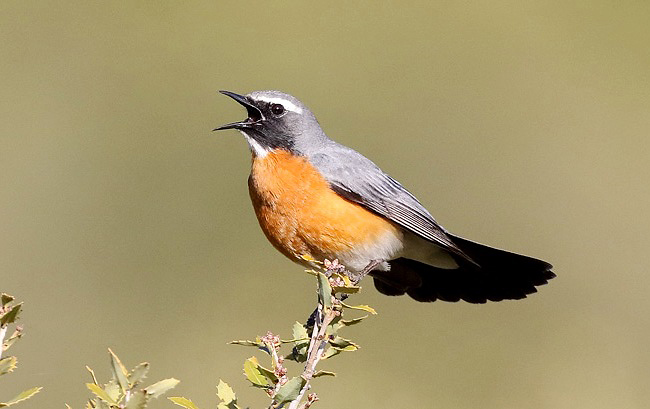
A singing male White-throated Robin at Seki in Turkey by Michael McKee.
Turkmenistan
This country of mainly black sand desert east of the Caspian Sea between Kazakhstan to the north and Afghanistan and Iran to the south, supports the
near-endemic Turkestan (Pander's) Ground-jay and Zarudny’s (Desert) Sparrow (both in the Turkmenabat region), as well as Caspian Snowcock, See-see
Partridge, Lammergeier, Asian Houbara (Macqueen’s) Bustard, White-tailed Lapwing, Black-winged Pratincole, Yellow-eyed Pigeon, Pallid Scops-owl,
Egyptian Nightjar, Blue-cheeked Bee-eater, White-winged Woodpecker, Pied Bushchat, Finsch’s, Red-tailed and Variable Wheatears, Streaked Scrub-warbler,
Asian Desert, Menetries’s and Sykes’s Warblers, Plain Leaf-warbler, Black-headed and White-crowned Penduline-tits, Eastern Rock Nuthatch, Bimaculated
Lark, Radde’s Accentor, Rosy Starling, Saxaul Sparrow, Pale Sparrow, White-winged Grosbeak, and Grey-necked and Red-headed Buntings. May is a good
time for birds and some of the best sites are the Karakum (Black Sand) Desert, the Amu-Darya, Murgab and Tejen river valleys, the Kopet Dag ('Many
Mountains'), and the Kugitang Mountains in the Tien Shan.
U
Ukraine
Demoiselle Cranes, Great Bustards, and Red-footed and Saker Falcons on feather grass steppes, and waterbirds in the Danube Delta region, including
Dalmatian and Great White Pelicans, Pygmy Cormorant, Pallas's (Great Black-headed) Gull, and passage migrant shorebirds and terns.
United Arab Emirates
A midwinter trip to the city parks, dairy farms, fodder fields, deserts, rocky mountain ridges, coastal mudflats and beaches of this safe, accessible
Middle Eastern country offers a fine selection of birds that includes Arabian and Sand Partridges, Socotra Cormorant, Indian Pond-heron, Eastern Imperial
Eagle, Grey-headed Swamphen, White-tailed Lapwing, Crab Plover, Cream-coloured Courser, Great Knot, Pallas's (Great Black-headed) and Sooty Gulls,
Chestnut-bellied and Lichtenstein’s Sandgrouses, Pallid Scops-owl, Pharoah Eagle-owl, Egyptian Nightjar, ('Arabian' kalbaensis) Collared Kingfisher,
Arabian Green Bee-eater, Indian Roller, Black-crowned Sparrow-lark, Greater Hoopoe-lark, Bar-tailed and Bimaculated Larks, Oriental Skylark, Pale Rock
Martin, Hooded, Hume’s, Red-tailed (Persian) and Variable Wheatears, Streaked Scrub-warbler, Plain Leaf-warbler, Arabian Babbler, Long-billed Pipit and
Striolated Bunting with a chance of Hypocolius. During the 'summer', mainly April to August, Persian Shearwater, and Bridled, Saunders's and White-cheeked
Terns may be seen.
Uzbekistan
The desert, steppe, many Mulberry trees (used to feed silkworms and produce silk on the ‘Silk Road’), mountain meadows and slopes covered in junipers and
coniferous forests below the snow-capped peaks of Uzbekistan support Turkestan (Pander's) Ground-jay (in the Kyzyl-Kum Desert), as well as Marbled Teal,
Asian Houbara (Macqueen’s) Bustard, White-tailed Lapwing, Little (Hutton’s) Owl, Blue-cheeked Bee-eater, White-winged Woodpecker, Asian Paradise-flycatcher,
Pied Bushchat, White-throated Robin, Blue-capped Redstart, Finsch’s and Variable Wheatears, Streaked Scrub-warbler, Asian Desert, Menetries’s, Moustached,
Sulphur-bellied, Sykes’s and Upcher’s Warblers, Azure (Yellow-breasted), Rufous-naped and Turkestan Tits, White-crowned Penduline-tit, Eastern Rock
Nuthatch, Hume’s Lark, Desert Finch, and Red-headed and White-capped Buntings. Good birding areas include the Chatkal range of mountains (outliers of the
Tien Shan near of the capital Tashkent), the Kyzyl-Kum Desert and wetlands around Bukhara. Mid-May is the peak time to look for birds.
V
Vietnam
Eleven endemic birds; Tonkin Partridge, Edward’s Pheasant, Annam Prinia, Annam Grasshopper-warbler, Black-crowned Fulvetta, White-throated Wren-babbler,
Collared, Golden-winged and Orange-breasted Laughingthrushes, Grey-crowned Crocias and Vietnamese Greenfinch, nearly 20 near-endemics shared with Cambodia
and Laos, including Germain’s Peacock-pheasant and Vietnamese Cutia, a superb selection of other classic fabulous South-East Asia birds such as trogons,
hornbills, broadbills, pittas, babblers and leafbirds, and some of the most beautiful primates in the world, including Buff-cheeked Gibbon and douc
langurs.
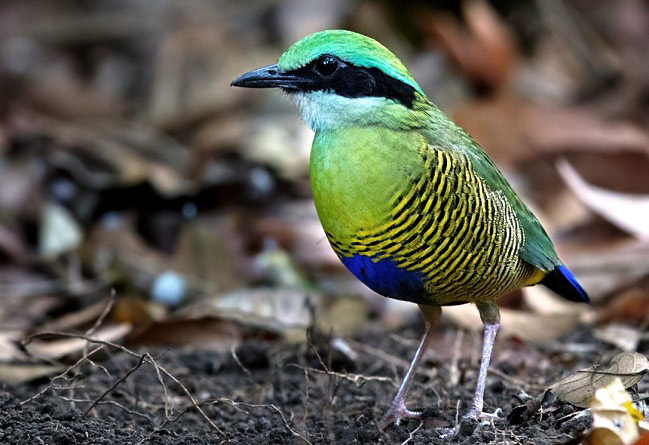
The best place in the world to see the beautiful Bar-bellied Pitta is Vietnam, where this image was taken by Lars Petersson.
W
Western Pacific Odyssey
An incredible selection of seabirds between New Zealand and Japan, from New Zealand Storm-petrel through Beck's Petrel and Heinroth's Shearwater to
Short-tailed Albatross, and many possible whales and dolphins, plus stopovers for endemic landbirds on New Caledonia and the Solomon Islands.
West Papua - Indonesia
Fantastic birds-of-paradise including Magnificent, Red, Wilson's, Western Parotia and Black Sicklebill, all displaying, mostly at close range, many other
spectacular New Guinea birds such as Palm Cockatoo, Victoria and Western Crowned-pigeons and Papuan (Blyth's) Hornbill, not forgetting some of the other
68 endemics such as Vogelkop Bowerbird, Vogelkop Lophornia (once known as Superb Bird-of-paradise), Arfak Astrapia, a chance of Long-tailed Paradigalla,
and, on offshore islands, in the richest tropical seas on Earth, Biak, Kofiau and Numfor Paradise-kingfishers.

New Guinea is not all about birds-of-paradise. The numerous other spectacular endemics include three species of huge crowned-pigeons including Victoria Crowned-pigeon which inhabits the northern lowlands where this fantastic image was captured by Nigel Voaden at Nimbokrang in West Papua.
Wetar
See Indonesia - Lesser Sundas, above.

